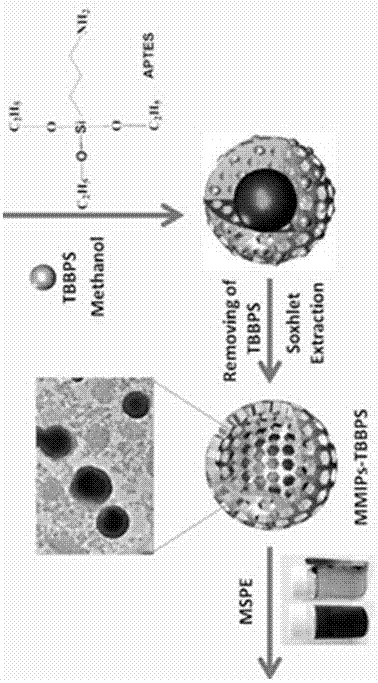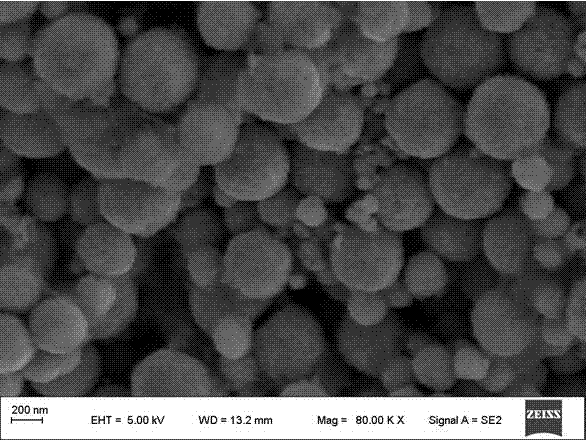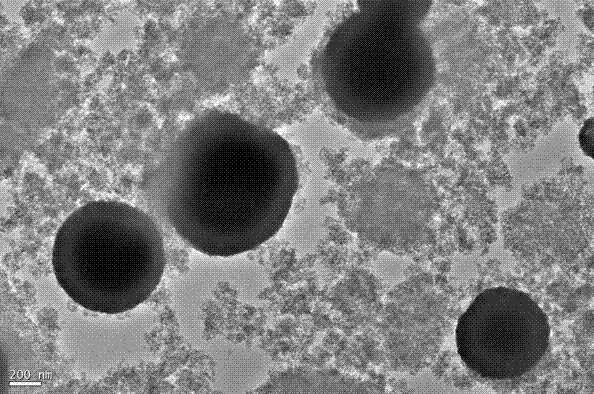Preparation of superparamagnetic mesoporous molecularly imprinted polymer of core-shell structure and application as solid phase extractant
A technology of magnetic molecular imprinting and core-shell structure, applied in alkali metal compounds, alkali metal oxides/hydroxides, inorganic chemistry, etc., can solve the problems of reduced binding force, mass transfer hindrance, time and labor waste, etc.
- Summary
- Abstract
- Description
- Claims
- Application Information
AI Technical Summary
Problems solved by technology
Method used
Image
Examples
Embodiment 1
[0056] (1) Fe 3 o 4 Preparation of Magnetic Nanoparticles
[0057] Add 0.86g FeCl to 30mL ethylene glycol 3 ·6H 2 O and 2.16g of sodium acetate, magnetically stirred to a uniform yellow solution, transferred to a reaction kettle, placed in an oven at 200°C for a constant temperature reaction for 12 hours, taken out and cooled to room temperature, and washed three times with ethanol and secondary water respectively to obtain Fe 3 o 4 The magnetic nanoparticles were dried in an oven at 60°C, and then ground for later use.
[0058] (2) Preparation of magnetically imprinted polymer MMIPs-TBBPS
[0059] Dissolve 0.5mmol (0.283g) of tetrabromobisphenol S and 2mLAPTES (3-aminopropyltriethoxysilane) into 10mL of anhydrous methanol solution and keep at room temperature for 2h to obtain solution I;
[0060] Accurately weigh 0.2gFe 3 o 4 Disperse the nanoparticles in 60mL of methanol and 10mL of distilled water, sonicate until completely dissolved; then add 4mLTEOS, 1mL of ammon...
Embodiment 2
[0065] (1) Fe 3 o 4 Preparation of magnetic nanoparticles: same as Example 1;
[0066] (2) Preparation of magnetically imprinted polymer MMIPs-TBBPS
[0067] Dissolve 0.5mmol (0.283g) tetrabromobisphenol S and 1.9mLAPTES (3-aminopropyltriethoxysilane) in 10mL of anhydrous methanol solution, and keep at room temperature for 2h to obtain solution I;
[0068] Accurately weigh 0.17gFe 3 o 4 Disperse the nanoparticles in 60mL of methanol and 10mL of distilled water, sonicate until completely dissolved; then add 3mLTEOS, 1mL of ammonia (28%), and stir for 5min to obtain solution II;
[0069] Add solution II to the above solution I, and stir mechanically at room temperature for 1 h; after the reaction product is taken out, wash with ethanol and deionized water for 5 times, and dry at 60°C to obtain a magnetic molecularly imprinted polymer;
[0070] The magnetic molecularly imprinted polymer was placed in a Soxhlet extractor, and was eluted with a mixed solution of methanol / aceti...
Embodiment 3
[0073] (1) Fe 3 o 4 Preparation of magnetic nanoparticles: same as Example 1;
[0074] (2) Preparation of magnetically imprinted polymer MMIPs-TBBPS
[0075] Dissolve 0.5mmol (0.283g) tetrabromobisphenol S and 2.1mLAPTES (3-aminopropyltriethoxysilane) into 10mL methanol solution and keep at room temperature for 2h to obtain solution I;
[0076] Accurately weigh 0.23gFe 3 o 4 Disperse the nanoparticles in 60mL of methanol and 10mL of distilled water, sonicate until completely dissolved; then add 5mLTEOS, 1mL of ammonia water (28%), and stir for 5min to obtain solution II;
[0077] Add solution II to the above solution I, and stir mechanically at room temperature for 1 h; after the reaction product is taken out, wash with ethanol and deionized water for 5 times, and dry at 60°C to obtain a magnetic molecularly imprinted polymer;
[0078] The magnetic molecularly imprinted polymer was placed in a Soxhlet extractor, and eluted with a mixed solution of methanol / acetic acid (9:...
PUM
 Login to View More
Login to View More Abstract
Description
Claims
Application Information
 Login to View More
Login to View More - R&D
- Intellectual Property
- Life Sciences
- Materials
- Tech Scout
- Unparalleled Data Quality
- Higher Quality Content
- 60% Fewer Hallucinations
Browse by: Latest US Patents, China's latest patents, Technical Efficacy Thesaurus, Application Domain, Technology Topic, Popular Technical Reports.
© 2025 PatSnap. All rights reserved.Legal|Privacy policy|Modern Slavery Act Transparency Statement|Sitemap|About US| Contact US: help@patsnap.com



